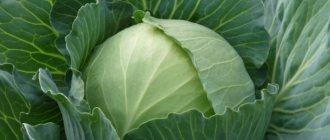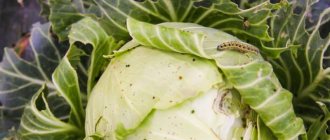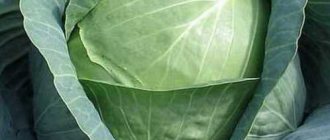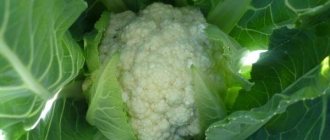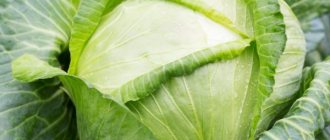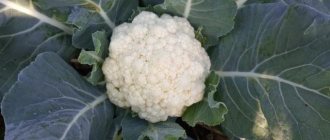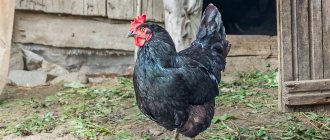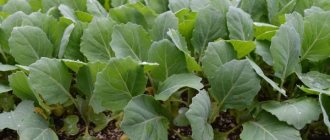Description of the variety
Moscow Late cabbage was bred by Russian breeders by crossing several varieties that were zoned in the Moscow region. To obtain high, high-quality yields, it is recommended to grow the Moscow Late variety in the Central, North-Western, Volga or Far Eastern regions of Russia.
The culture belongs to the late species, as is clear from the name. The period of plant development from germination to harvest is 120-140 days, depending on care and place of cultivation.
The rosette of leaves is large, voluminous, up to 90 cm in diameter, which is important to consider when planting
The rosette of leaves is large, voluminous, up to 90 cm in diameter. This is important to take into account when planting, so that the plants do not interfere with each other’s growth. The leaves are large, there are small but frequent wrinkles on the leaf blade. The color of the upper leaves is gray-green with a waxy coating, and the cross-section of the leaves is white. A ripe head of cabbage is dense. The petioles are long, the veins are sparse. The average weight of ripe cabbage is 4-6 kg, but there are champions weighing up to 15 kg! The inner stalk is short or medium in size, and the outer stalk is quite long.
Interesting!
You can find two varieties of this variety on sale. Moscow Late 15 and 9. Moscow Late 9 cabbage was developed from the first variety labeled 15 and has higher clubroot resistance. Otherwise, their characteristics are identical.
List of similar varieties
Late cabbage is in high demand among gardeners. Late varieties are enriched with vitamins and sugars, are distinguished by high shelf life and resistance to diseases, pests, and rotting.
You can replace Moscow late with other similar late varieties.:
- Amager 611 . It is distinguished by bitterness - this is a natural protection against pests. After harvesting and storing it, the bitterness disappears. The weight of the heads of cabbage reaches 3 kg. Productivity up to 6.5 kg per 1 sq.m. We talked about Amager cabbage here.
- Aggressor . Late variety of cabbage. Developed in Holland (read about Dutch cabbage selection here). Does not require careful control during cultivation. The weight of the heads reaches 5 kg. Productivity from 8 to 9 kg.
- Mara . Resistant to temperature changes, disease, and rot. Average weight – 4 kg.
- Kharkov winter . Tolerates temperature changes well. Weight reaches 4 kg. Productivity up to 9 kg per 1 sq.m.
- Wintering 1474 . Has a long shelf life. Weight up to 3.5 kg. Productivity up to 6 kg.
How not to make a mistake when choosing a cabbage variety for fresh storage in winter, read here.
Characteristics of Moscow Late cabbage
Also check out these articles
- Apricot Triumph northern
- Rhode Island chicken breed
- How to store cabbage in the cellar in winter
- How to prune currants correctly in the fall
The advantages and disadvantages of Moscow Late cabbage are presented in the characteristics.
- The variety is used for cultivation in private, small plots and for industrial purposes.
- Late Moscow cabbage is grown in open ground. It is not suitable for greenhouses.
- There is resistance to clubroot and most other diseases.
The color of the upper leaves is gray-green with a waxy coating, and in cross-section the leaves are white
- Heads of cabbage may crack, but this rarely happens.
- Heads of cabbage of commercial appearance.
- Transport quality is average.
- The yield per hectare, according to farmers, reaches 6-12 kg per square of plantings.
- It is stored under proper conditions for about 3 months.
- Universal use.
Advantages and disadvantages
Pros:
- excellent taste fresh and after processing;
- long shelf life;
- high commercial qualities;
- good yield;
- resistance to cold and adverse conditions;
- heads of cabbage are not prone to cracking;
- Keel resistance;
- content of vitamins and ascorbic acid.
Minuses:
- due to the long outer stump, the heads of cabbage may fall to one side;
- Harvest harvested before the first frost is stored worse.
Features of planting Moscow late
You can grow Moscow Late cabbage using seedlings or seeds. But the seed planting method is chosen, as a rule, in the southern regions, where the warm season lasts quite a long time. The seedling method is more popular and is used everywhere.
Seedling growing method
Planting seedlings in a permanent place is carried out according to the 60x60 cm scheme
Seeds for seedlings are sown around the beginning of March. First, they are soaked in water (+70 degrees) for half an hour, then washed under cold water. Sowing is carried out in a common container to a depth of 1 cm. A distance of 5-7 cm is left between the seeds. The seeds germinate at a temperature of +23 degrees, but after the sprouts appear, it is better to reduce the temperature to +17 degrees maximum, so that the sprouts do not stretch and the root system developed normally.
Planting seedlings in a permanent place is carried out according to the 60x60 cm pattern. It is important to wait until the ground warms up, otherwise the sprouts will freeze and development will slow down.
Important!
Cabbage grows best on black soil or sandy soil. The acidity of the soil should be at level 5. If it is higher, you should add lime or dolomite flour before planting cabbage.
Seed planting method
Sowing seeds directly into open ground is carried out from the end of April
Sowing seeds directly into open ground begins in late April. They are buried in the ground by about 3 cm, no more. The distance between seedlings is 40 cm. Initially, you can sow 2-3 seeds per hole. When they sprout, 1 is left - the strongest sprout, and the rest are replanted or removed. After sowing the seeds, it is worth covering the area with film. This will create a greenhouse effect and the seeds will germinate much faster.
Agrotechnics of cultivation
Late varieties of cabbage are grown only through seedlings. The old method of sowing seeds directly into the ground can be used by gardeners in the southern regions, but there is no particular need for this. Growing seedlings is a simple and not too troublesome activity that any gardener can master.
By the time of planting in the garden, the plants should be 45-60 days old, up to 20 cm high and have 4-6 true leaves, which means they start work in March - April. For cabbage, prepare low boxes, cassettes, peat or plastic pots. Plants develop best in soil that is light in structure and fertile, so you can either prepare it yourself in advance or purchase it in a store.
There is no special preparation of seeds for sowing. Seeds from packs from a trusted manufacturer have already been treated with fungicides, therefore, they can be planted dry. But in the presence of growth stimulants, you can keep the seeds in them to obtain more friendly and early shoots.
Cabbage seeds are small, so they are planted in the soil to a depth of only 0.5-1 cm, after thoroughly moistening the soil. Containers with future seedlings are placed in a room with a temperature of 18-22 ˚C and covered with film. After the sprouts appear, the plants are watered as the soil dries, well lit and kept at 14-16˚C during the day and no higher than 10˚C at night. This allows the cabbage to grow strong and not stretch out. During cultivation, 1-2 feedings are carried out with complex fertilizers. They are combined with watering so as not to burn the roots of the plants.
If we talk about the late Moscow cabbage variety, then the seedlings are planted in the ground in May. In the fall, a well-lit area filled with organic matter and mineral fertilizers is prepared for the plants. The best results are obtained when growing the crop on light loams. Cabbage does not tolerate very acidic soils and shade. In the first case, it develops poorly, in the second, it produces loose small heads of cabbage.
Late-ripening cabbage of this variety is planted according to a 70 by 80 or 80 by 80 cm pattern, after which the beds are well moistened. Caring for plantings consists of loosening the soil, weeding, preventive and scheduled treatments against pests. For the growth and formation of large heads of cabbage, regular watering will be required, especially at the final stage of the growing season, as well as fertilizing with organic and mineral fertilizers: 3-4 per season will be enough to obtain a good harvest.
25 days after planting this variety, the plants are earthed up after watering or fertilizing. The second time the procedure is carried out after 10-12 days.
Caring for Moscow Late cabbage
We recommend reading our other articles
- The best table grape varieties
- Meat breeds of sheep
- Important tips for choosing a generator for your home or cottage
- Cabbage variety Megaton F1
Caring for cabbage must be in accordance with all the rules, otherwise you cannot expect a high-quality harvest.
- Late Moscow cabbage requires regular, moderate watering. You need to moisten the soil so that it is saturated, but not waterlogged, otherwise root rot will occur. Usually 1 watering per week is enough; during drought, you can add water once every 3 days. One head of cabbage should consume up to 3 liters of water.
- After watering and precipitation, it is important to loosen the soil so that it is soft and fluffy. At this time, weeds are uprooted and burned off-site or added to the compost.
It is necessary to moisten the soil so that it is saturated, but not to become waterlogged, otherwise root rot will occur.
- Fertilizing is done 2 times a year. The first time you need to apply fertilizer 3-3.5 weeks after planting the seedlings. Organic matter is used - 2 kg of humus per 10 liters of water. Up to 1.5 liters of the resulting solution is poured under the bush. The second feeding is done when the heads begin to form. For 10 liters of water take 20 mg of potassium and the same amount of nitrogen. Up to 2 liters of solution should go under the head of cabbage.
- Mulching is not necessary, but recommended. Cabbage gets sick less often if you cover the ground with a thin layer of sawdust, compost or similar mulch.
- To prevent the cabbage from falling on its side and cracking, it is recommended to carry out regular hilling.
- The lower leaves can be picked off after the cabbage reaches maturity. This procedure eliminates rotting and prevents the occurrence of diseases. In addition, the plant will put more effort into forming a head of cabbage.
Growing technology and care
Before planting, the seed material should be soaked in warm water for half an hour. Then rinse it thoroughly in running water. It is recommended to plant seeds in a common container to a depth of 1 cm. The distance between plants should be 5-7 cm.
The room temperature should be +23 degrees. When sprouts appear, this parameter is reduced to +15..+17 degrees during the day and to +8..+10 degrees at night. This ensures full development of roots and adapts the crop to planting in open soil.
Planting seedlings in the ground
The area for cabbage needs to be prepared in the fall. At this stage, it is recommended to add organic matter and minerals. It is important to choose a sunny area for the plant with a predominance of slightly acidic or neutral loamy soil. Acidic soil is not suitable for cabbage.
Attention! The plant is prohibited from being planted in beds where crops from the Cruciferous family previously grew.
Seedlings must be planted in dug up soil, maintaining an interval of 80 cm. This distance must also be left between the rows. After completing the planting work, the beds must be thoroughly watered.
After planting seedlings in open ground, the bushes need to be well watered.
Watering and fertilizing
The plant needs regular but moderate watering. Excessive soil moisture leads to the development of root rot. The beds need to be watered once a week. In this case, it is necessary to use 3 liters of water per bush.
During the growing season, plants need to be fed twice:
- 25 days after planting the crop in open ground. At this stage, organic products are used. It is best to use humus or a solution of bird droppings.
- At the stage of fruit formation. At this time, cabbage needs potassium and nitrogen.
Loosening and hilling the soil
After each watering, the soil must be loosened. This provides the roots with the maximum amount of oxygen and nutrients. To reduce the amount of loosening, the bed should be covered with a mulching layer of straw, hay or sawdust.
Attention! Cabbage has a tall stalk that may not support the weight of the head. Therefore, during the season you should rake the soil to the heads of cabbage 3 times.
The first time the procedure is carried out after planting the seedlings. Then you need to control the growth rate of the stalk. When the head of cabbage rises a few centimeters above the ground, it needs to be hilled up.
Diseases and pests of the variety
Late Moscow cabbage variety is resistant to many diseases. She even rarely gets sick from fungal diseases. If there are concerns, you can carry out treatment (preventive) with special preparations, but usually gardeners do this only if signs of illness appear. So, for diseases you can use such drugs as “Fitosporin-M”, “Planriz”, “Fundazol”, “Albit”, “Gamair”.
The butterfly does not like treatment with Bordeaux mixture - 10 mg per 10 liters of water
Interesting!
To prevent slugs from spoiling the heads of cabbage, you can mulch the area under the bushes with broken walnut shells, eggshells or seed husks. And simple tulle can help against cabbage butterflies. They cover the heads of cabbage with it and press it on the sides to the ground so that it does not rise from the wind.
Of the pests, the plant is most often attacked by butterflies, fleas, and aphids. For fleas, you can use a solution of potassium permanganate (20 mg/10 l of warm water). The butterfly does not like treatment with Bordeaux mixture - 10 mg/10 l of water. Aphids disappear when cabbage is sprayed with “Assistant”, “Inspector”, “Alpha-Super” or similar preparations. Colloidal salt (50 g/10 l of water) also helps quite well. Treatments are carried out no more than once every 10 days, or less frequently.
Description, photo
The hybrid was bred in the early 60s by breeders of the Moscow Society of Natural Scientists at Moscow State University named after M.V. Lomonosov by crossing the new Cinnamon and the Northern Sinap variety. The author was the famous breeder S.I. Isaev.
Official zoning took place much later – 40 years later.
Refers to late winter ripening varietal crops . The tree is tall. While the tree is young, the crown is characterized by a wide pyramidal appearance, which over the years turns into a rather wide oval.
The color of the trunk and main branches is green-gray. The main arrangement of branches is vertically inclined. The sheet covering is characterized by average performance.
The shoots are smooth, round in shape, have strong pubescence and a brownish-brown tint. The sections of the stem between two adjacent shoot nodes are short. The leaves are large, have jagged edges and short, fleecy petioles.
The fruits are considered quite large. The usual weight is about 160 g, but specimens grow up to 230 g. The apples are smooth, round, and cone-shaped.
The skin is smooth, without pearls and ribs. Important! Removable maturity coincides with consumer maturity.
The main color of apples: yellow-green. A slight blush appears on . After long-term storage, the color changes to golden and resembles a waxy fruit.
Fruits of the Moscow apple tree later.
Harvest and storage
Due to the density of the heads of cabbage, the crop can be harvested manually or mechanically. Heads of cabbage are usually collected after the first autumn frosts. If you collect them earlier, the shelf life will be reduced. The cabbage is cut with a sharp knife and folded so that the top leaves are not damaged. At the same time, it is worth removing the remaining tops with rhizomes.
The heads of cabbage are collected after the first autumn frosts. If you collect them earlier, the shelf life will be reduced.
The harvest is perfectly stored at a temperature of +1 degrees and humidity in the range of 90-95%. The use of Moscow Late cabbage is universal. It is suitable for fresh food, pickling, and fermentation.
Rules of care
Late varieties are loved because they require virtually no care. Unlike early-ripening cabbage, Moscow Late cabbage rarely gets sick and does not require the constant presence of a gardener.
Here's how to care for cabbage beds:
- Water during periods of drought using settled warm water. Watering should be done at the root, best done in the evening, when the heat has subsided. When the heads of cabbage are formed, the amount of watering is halved to prevent the cabbage from cracking.
- Cabbage loves fertilized soil; it accepts organic matter best - cow manure or bird droppings diluted in water. The crop needs to be fertilized three times during the summer: 20 days after planting the seedlings, two weeks after the first fertilizing, and another 10-12 days.
- Moscow Late mulching is well tolerated. The soil is covered with a layer of humus or compost, thereby further saturating it and preventing cracking.
- To prevent diseases and pests, you can use an insectofungicide or adopt traditional methods, such as wood ash, dolomite flour, decoctions of tomato tops, garlic, onions, and wormwood.
- Weeds between cabbage beds are regularly removed; they not only draw strength from the plant, but also contribute to the proliferation of insects and slugs.
- Cabbage bushes need to be regularly hilled, raking the soil to the roots. This tactic will help prevent the heads of cabbage from falling to one side and coming into contact with the ground.
- If hilling does not help, the fallen cabbage is strengthened with supports or pegs.
- The Moscow Late crop is harvested at one time - when the first frost has passed. The heads of cabbage are carefully cut with a sharp knife and folded, being careful not to damage the upper leaves. The tops must be pulled out along with the roots (if necessary, dug up with a shovel or pitchfork) and taken away from the site.
Important! The harvest should be stored in a cool place with above-zero temperatures and low humidity.
Next season, cabbage seedlings are planted in another place; the land must “rest” from this crop for at least two to three years.
Reviews from gardeners about the Moscow Late cabbage variety
The opinions of gardeners about the Moskovskaya Pozdnyaya cabbage variety can be studied below.
- Lyubov Kvitchinska : “I know Moscow cabbage Late 15 firsthand. I grew it for many years until I “met” more modern hybrids. The cabbage itself is not bad, and is stored better than many other varieties, and it rarely gets sick, but such cabbage requires regular hilling or supports under the heads of cabbage. It grows on a long head of cabbage, the head itself is large, so it can fall to the ground and break under its own weight. In addition, with frequent rains, the heads of cabbage crack and are then poorly stored. So this variety is not bad for practice, but there are better ones.”
- Stanislav Belyaev : “I grow Moscow Late cabbage every year for storage. She is growing well and has almost no illnesses. The taste of cabbage that has already rested is pleasant and juicy. It lies in the basement without problems until April. I have not yet found a more profitable variety to grow. There are, of course, similar analogues, but they either suffer from taste or suffer from everything possible.”
- Yana Kurys : “Moscow Late 15 is a worthy old variety of cabbage. There is always a high demand for it. I have been growing it for more than 5 years. Every year I learn something new, but without a doubt there is only one thing - the variety needs quality care. Weeding, watering, hilling, fertilizing are the foundation for obtaining a good harvest. Also, a couple of times a year it may be necessary to treat pests, and the variety rarely gets sick because it has strong immunity.”
Description
As the name itself suggests, cabbage is a late-ripening variety. The full growing season of the vegetable is 115-140 days.
This is a rather spreading plant that takes up quite a lot of space on the site. Therefore, it is planted not according to the standard scheme, but according to the scheme 70x80, 80x80 cm.
The leaf rosette of the plant is very spreading and voluminous (90-110 cm in diameter). The leaves are wrinkled, large, oval or round. The color of the leaves is gray-green, there is a slight coating on the surface. The edge of the leaf is without characteristic wavy, smooth to the touch. Leaf veins are few and rigid.
The variety is famous for its large and juicy heads of cabbage. The standard weight of a mature “head” is about 4-6 kg (often summer residents manage to grow heads of cabbage weighing 10-14 kg. The peak weight of the vegetable is 18 kg. The shape of the head of cabbage is round or flat-round. The color in section is white-yellow. The inner stump is small, but quite wide up to 30 cm in length.The outer stump is up to 30 cm long and as wide as the inner one.
What are the benefits of aloe, can it harm? Recipes with honey and other ingredients for immunity and health
Moscow late is a high-yielding variety. On average, from 1 hectare of plantings you can collect from 60 to 90 tons of products. Of the total harvest, approximately 90-95% is suitable for sale on the market.
Cabbage is versatile. Suitable for preparing fresh salads, borscht, cabbage rolls and for pickling. At one time it was even the best variety for pickling.
Heads of cabbage are stored for 5-6 months, until approximately February. Transportability is average.
The culture is demanding on the type of soil and depends on watering. It has good immunity, which protects it from most cabbage diseases and pests. Also, Moscow late is not characterized by cracking of heads of cabbage.
Harvest after the first frost. This is done so that the heads of cabbage become less rough.
What are the disadvantages and advantages of a hybrid?
Valentina has few shortcomings, but she does have them. So, for example, the promised high yield can only be obtained under favorable conditions, which can certainly only be hoped for in a greenhouse.
In particular, Valentina cabbage is demanding on temperature conditions. If the mercury column of the thermometer drops below 15 degrees Celsius during the formation of heads of cabbage, then there is a high probability of plant growth stopping. In the opposite case - when the air temperature is about 30 degrees and above - Valentina cabbage is able to completely disappear into the leaves, forgetting about tying the heads.
The hybrid makes no less claims about proper watering. In regions with high humidity, gardeners noted that Valentina cabbage forms small heads with thick leaves and does not gain its commercial attractiveness. In addition, loose heads of cabbage are stored worse. Drought, which often affects the south of Russia, also has a negative impact. With a prolonged lack of moisture, growth is inhibited, and this, due to the length of the growing season of the hybrid, is akin to yield loss.
If we talk about the advantages, there are undoubtedly many of them:
- Excellent keeping quality. If you manage to grow a good harvest, it will last for six months or more without problems.
- Excellent transportability. Industrial manufacturers have noted that even when transporting Valentina cabbage over long distances, the forks do not lose their attractiveness.
- Amazing taste qualities that not only do not deteriorate during storage, but also increase.
- Moderate resistance to disease and cracking. Valentina cabbage is immune to all known diseases. Plants are especially resistant to fusarium.
- Doesn't require much space for planting. A compact raised rosette with small leaves allows you to grow cabbage in a 60x60 cm pattern.
- Does not require hilling. The medium-sized external stump allows you to forget about adding soil under the stem while weeding.
- Presentable appearance. The dense, medium-sized heads have a whitish tint when cut, which attracts buyers.
- Frost resistance. Grown forks are not afraid of frosts down to minus five. On the contrary, when harvesting after the first cold snap at night, Valentina cabbage only becomes sweeter.
Pest and disease control
This variety is relatively resistant to rot and clubroot, but prevention should not be neglected.
- When planting seedlings, pour a handful of ash and a few peas of black pepper into the hole made.
- Against cabbage butterflies, you can spray a powder made from a mixture of ground snuff and ground black pepper onto the soil immediately after watering. You can also powder the leaves with it.
- For cabbage butterfly and cutworm - treat with sweet water, a solution of ash with tar soap dissolved in it.
- Cover cabbage with non-woven material to prevent cruciferous flea beetle. And also sprinkle the leaves with dust from ash or tobacco. Plant rows of garlic next to the cabbage beds. Add fir oil to the water and spray the heads of cabbage.
- Baits will help against snails or slugs - slightly buried trays with drinks poured into them: kvass, juice or beer. You can sprinkle mustard powder between the rows.
- For cabbage aphids, spray with infusions of tomato tops, mustard infusions and tobacco dust.
- Caterpillars of the cockchafer and cutworm butterflies, as well as cabbage flies, are fought with the help of ordinary garden ants. You need to try to attract them with something sweet: jam, scattered pieces of sugar.
- For mole crickets, aphids, and slugs, dissolve 10 ml of ammonia in a bucket of water. Before planting seedlings, pour 200 - 300 ml into each hole. the resulting solution. This solution can be used to treat leaves, but you should add a little grated laundry soap.
Growing the variety
The variety under discussion does not have any special differences from the cultivation of other late-ripening cabbage varieties.
Seed preparation
The quality of the harvest depends on the quality preparation of seeds for sowing.
Before sowing cabbage seeds you need:
- Place in water heated to + 50°C for 15 minutes.
- After that for 1 min. immerse in cold water.
- Then soak for half a day in a mixture of microelements dissolved in water.
- Next, rinse the seeds thoroughly in clean water and place them in the refrigerator on the bottom shelf for 24 hours.
- After this, dry the seeds and begin planting them in the prepared substrate.
Agricultural technology and subtleties of cultivation
Seeds are sown in early April. The immersion depth should be 1 cm. Within a week, the first shoots appear. After 45 days, you can transplant the seedlings into open ground. This happens most often at the end of May. The soil should be rich in organic elements. A growing site should be selected with a low relief. Cabbage planted after cucumbers and potatoes produces an excellent harvest.
If you care for cabbage correctly and regularly, you can count on harvesting an excellent harvest. To do this, it is necessary to carry out irrigation measures. Timely, abundant watering is very important, especially during dry periods. Feeding is also necessary. The area planted with cabbage must be cleared of weeds. After watering, you need to hill up and loosen the soil.
The crop should be harvested after the first frost. But if the sub-zero temperature has not yet arrived, and the head of cabbage is already ripe, then in order to avoid cracking it is necessary to grab it and turn it in a circle. Thus, the roots of the plant will break off and it will stop growing. This procedure will not affect the quality of the product.
Features of cultivation
The Moscow late variety is best used for planting in the northwest and central regions of Russia, as well as the Far East.
In the fall, it is necessary to take care of soil fertility in advance.
- Apply natural natural fertilizer - manure or humus, 4 - 6 kg per square meter. m. Can be applied directly and at the root, when planting seedlings. You will need 0.5 kg for each bush.
- Another fertilizer option is to apply urea from 28 to 36 g per square meter. m., simple superphosphate from 37 to 47 g. per sq. m and potassium chloride 21 - 32 g. per sq. m.
- You can use nitroammophoska for digging - 1 teaspoon. l. into two holes when planting seedlings.
- Nitrophoska 60 - 90 gr. per sq. m.
- Azofoska from 20 to 25 gr. per sq. m.
- Ammofoscamide - 40 - 50 per square meter. m.
Growing
The best preceding and intermediate crops at the site of future cabbage planting:
- beet;
- potato;
- cucumber;
- carrot;
- onion;
- pepper;
- pumpkin;
- tomato;
- herbs;
- legumes
Cabbage and other vegetables from the cabbage family, for example, radishes, radishes, can be planted in the same place no earlier than after 3 or 4 years. And if clubroot disease was also observed, then no earlier than 7 years.
Sowing seeds
Seeds for seedlings of late-ripening varieties intended for planting in the ground are sown from March 25 or 30 until the second ten days of April, or at least until April 25. Basically, seeds are planted in 2-3 pieces in separate cups with nutritious soil to a depth of 2 cm.
Nutrient soil for growing seedlings is prepared from a mixture of soil and:
- manure or compost;
- turf or garden soil;
- peat and sand in a ratio of 1–2: 2: 2: 1.
seeds
Add 5 grams to a bucket of this mixture. urea, 20 - 25 gr. superphosphate, 5 g. potassium salt and 1/2 liter of ash or 30 - 50 g. fertilizer mixture Stimul or Growth.
The mixture for peat manure pots is prepared from:
- humus 2 - 3 parts;
- peat 6 - 7 parts;
- turf soil - 1 part.
Add 5 grams to a bucket of this mixture. urea, 20 gr. superphosphate, 5 g. potassium salt.
If for some reason there is no peat, instead you can take humus and turf soil in a ratio of 16:4 parts. Add 3 - 5 grams here. ammonium nitrate and 10 - 15 g. superphosphate per bucket of mixture.
Advice! You can sprinkle the surface of the area intended for sowing seeds with tobacco dust to prevent pests.
When planting a seed in a hole you have made, you should add a little wood ash there.
Under containers for seedlings you can take cups of ice cream, yoghurt and others.
When the seedlings grow up, the strong shoots are left, the weak ones need to be removed.
You can start sowing seeds under the film at the end of April. The best temperature for seed germination is from 17 to 20 degrees. After planting, seedlings appear on the 7th or 12th day.
Planting seedlings in the ground
It is important to provide the seedlings with the correct temperature so that they do not drag and grow strong. In sunny weather the thermometer should show 16 degrees, and in cloudy weather it should be at least 13 degrees.
At night, a decrease to 7 is acceptable. For favorable development of seedlings from germination to the formation of the first leaf, the best temperature is from 6 to 10 degrees Celsius.
- Seedlings can be fed with: ammonium nitrate - 13 - 14 g/m²; simple superphosphate - 26 g/m² and potassium chloride - 11 g/m².
- Dilute bird droppings or cow manure in water and fertilize three times during the summer.
Note! Before planting seedlings in the garden, it is useful to harden them. To do this, you need to take the cuvettes or cups out into the fresh air for a while.
The Moscow late variety is demanding on soil fertility and moisture. It grows better on floodplain soils, as well as deeply dug and breathable, moisture-intensive soils with a neutral reaction of the soil solution and sod-podzolic chernozems and peat bogs. If you come across an area with poor sandy soil or heavy acidic soil, before planting seedlings it needs to be thoroughly fertilized with manure or humus. But excess moisture is also harmful, because then plants can be affected by vascular bacteriosis.
You need to plant seedlings in the garden when they are at least 35 days old and have 5-6 leaves. This is usually the period from May 20 to May 30. Planting depth 8-10 cm. Planting density 2.5 - 3 plants per square meter. m.
Important! Be sure to water the seedlings with 0.5 - 0.7 liters of settled, non-cold water at the root. And then, during the rooting process, water daily. . Cabbage bushes should be spaced 8x8 cm apart from each other and no thicker than 60x70 cm in order to provide them with sufficient feeding area in the future.
Can be seated in a checkerboard pattern
Cabbage bushes should be spaced 8x8 cm apart from each other and no thicker than 60x70 cm in order to provide them with sufficient feeding area in the future. Can be seated in a checkerboard pattern.
It is better to choose a place on the site that is not shaded and sunny.
After planting the seedlings in the ground, in the rosette phase, feed g/sq. m.: ammonium nitrate - 6; simple superphosphate 13 and potassium chloride 5 - 6.
Ripening and fruiting
The Moscow apple tree is a typical winter-ripening variety.
Beginning of fruiting
In the process of creating the variety, rather late fruiting was planned. It was assumed that the fruit could only be harvested after 10 years. But in practice everything turned out differently. The fruits can be collected in the 7th year.
Peculiarities
Gardeners note that fruiting is stable and excellent. But there is one interesting feature that is not typical for winter varieties: the fruits can be eaten immediately after they are picked from the apple tree.
Flowering time
The tree is completely covered with bright flowers in the second half of May and this lasts no more than 10 days. But climatic features and weather conditions can make adjustments.
Apple tree blossom.
Fruit ripening
The fruit harvest time is late. The harvest is ready for harvest in the third ten days of September.
Harvest and storage
A special feature is the long shelf life of the crop. Under proper conditions, they lie well even until June. And in special refrigerators they even retain their appearance and taste until the next harvest.
